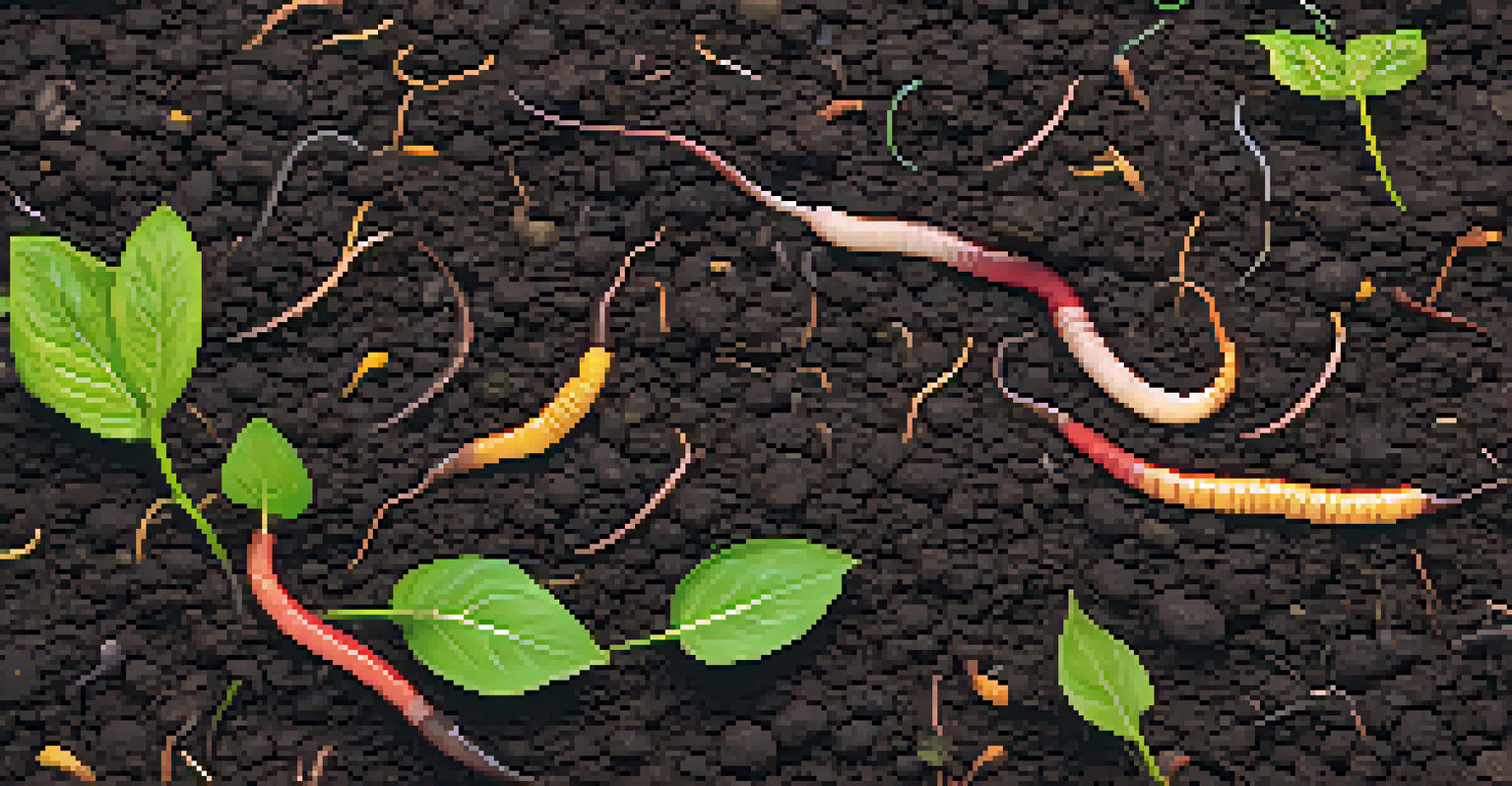The Importance of Soil Health for Wildlife-Friendly Gardens

Understanding Soil Health and Its Benefits
Soil health refers to the condition of soil and its ability to sustain plants, animals, and humans. Healthy soil is rich in organic matter, nutrients, and microorganisms, all of which contribute to a thriving ecosystem. When soil is well-maintained, it supports plant growth, which in turn provides food and habitat for wildlife.
Healthy soil is the foundation of healthy plants, which are the foundation of healthy ecosystems.
A garden with healthy soil can naturally attract beneficial insects, birds, and other wildlife, creating a balanced and thriving environment. For example, earthworms aerate the soil while breaking down organic material, enriching it and making it more fertile. This not only benefits the plants but also creates a haven for various creatures that rely on a healthy ecosystem.
Moreover, healthy soil can improve water retention and reduce erosion, allowing plants to flourish even during dry spells. By prioritizing soil health, gardeners can create wildlife-friendly spaces that contribute to biodiversity and promote ecological balance.
The Role of Organic Matter in Soil Health
Organic matter, such as compost, leaves, and grass clippings, plays a crucial role in enhancing soil health. It improves soil structure, increases nutrient availability, and boosts the population of beneficial microorganisms. These elements are vital for creating a thriving habitat for various wildlife species.

For instance, adding organic matter to your garden can attract earthworms and beneficial insects, which help aerate the soil and break down organic materials. This creates a nutrient-rich environment that supports plant growth and provides food sources for birds and other wildlife. A garden with ample organic matter is not only healthier but also more inviting to a diverse range of creatures.
Healthy Soil Supports Ecosystems
Maintaining soil health enriches the environment, providing essential nutrients and habitats for plants and wildlife.
Incorporating organic matter into your gardening routine not only nourishes your plants but also fosters a rich ecosystem. By composting kitchen scraps and yard waste, you contribute to the cycle of life in your garden while promoting soil health and attracting wildlife.
Minimizing Chemical Use for Soil and Wildlife
The use of synthetic fertilizers and pesticides can harm soil health and wildlife. These chemicals can disrupt the delicate balance of microorganisms in the soil, leading to reduced fertility and plant health. Additionally, they can contaminate water sources, affecting not just plants but also the wildlife that relies on them.
The soil is the great connector of our lives, the source and destination of all.
By minimizing chemical use in your garden, you not only protect the soil but also create a safer environment for wildlife. Natural alternatives, such as organic fertilizers and pest control methods, can be just as effective without the harmful side effects. For example, using neem oil as a pesticide can help manage unwanted pests while being safe for beneficial insects.
Shifting towards organic gardening practices not only benefits your plants but also supports the entire ecosystem. Healthy soil nurtured by organic methods can create a sanctuary for wildlife, fostering a vibrant garden community.
Creating Diverse Plant Communities for Wildlife
Diversity in plant life is essential for a wildlife-friendly garden. By planting a variety of species, you can provide food and habitat for different wildlife, from pollinators like bees and butterflies to birds and small mammals. Each plant plays a unique role in supporting the ecosystem.
For instance, native plants are particularly beneficial as they are adapted to the local climate and soil conditions. They require less water and maintenance while attracting local wildlife that relies on them for food and shelter. By incorporating a mix of flowering plants, shrubs, and trees, you create a more inviting environment for animals.
Organic Matter Boosts Soil Vitality
Incorporating organic matter enhances soil structure and nutrient availability, fostering a thriving ecosystem.
Encouraging biodiversity in your garden not only enhances its beauty but also establishes a healthier ecosystem. A diverse plant community contributes to soil health and provides essential resources for wildlife, creating a sustainable environment for all.
Water Management: Supporting Soil and Wildlife
Effective water management is key to maintaining both soil health and wildlife habitats. Proper irrigation techniques ensure that plants get the moisture they need without over-saturating the soil, which can lead to erosion and nutrient loss. This balance is crucial for creating a thriving garden ecosystem.
Rain gardens and permeable surfaces can help manage stormwater runoff, allowing water to soak into the ground and nourish the soil. These practices not only support healthy plants but also create habitats for amphibians, insects, and other wildlife that rely on water sources. By designing your garden with water management in mind, you contribute to the overall health of the ecosystem.
Furthermore, collecting rainwater in barrels for irrigation is an eco-friendly way to manage water efficiently. This not only conserves resources but also provides a reliable water source for your plants and wildlife during dry spells, enhancing the resilience of your garden.
The Impact of Soil Health on Pollinator Populations
Soil health is closely linked to the well-being of pollinators such as bees and butterflies. Healthy soil supports a diverse range of flowering plants, which in turn provide essential nectar and pollen for these vital creatures. Without healthy soil, the plants that sustain pollinators cannot thrive, leading to declines in their populations.
For example, gardens rich in organic matter and diverse plant species can attract a variety of pollinators. By planting flowers that bloom at different times throughout the season, you ensure that there is a continuous food source for these insects. Pollinators play a crucial role in the ecosystem, and by fostering soil health, you can help maintain their populations.
Diverse Plants Attract Wildlife
Planting a variety of species creates food and shelter for wildlife, promoting biodiversity in the garden.
Creating a pollinator-friendly garden also encourages a vibrant community of wildlife. By prioritizing soil health and planting a variety of nectar-rich flowers, you can support not just pollinators but also a broader range of wildlife that relies on a healthy ecosystem.
Best Practices for Maintaining Soil Health
Maintaining soil health is an ongoing process that involves several best practices. Regularly adding organic matter, practicing crop rotation, and minimizing soil disturbance are effective strategies to keep your soil healthy. These practices not only enhance soil fertility but also promote a thriving garden ecosystem.
Cover crops can also play a significant role in maintaining soil health. They protect the soil from erosion, add nutrients, and improve soil structure. By planting cover crops during the off-season, you can ensure that your soil remains healthy and productive throughout the year.

Lastly, regular soil testing can help you understand your soil's specific needs. By knowing what nutrients your soil may lack, you can make informed decisions about amendments and practices that support healthy soil, ultimately benefiting both your garden and the wildlife that depend on it.